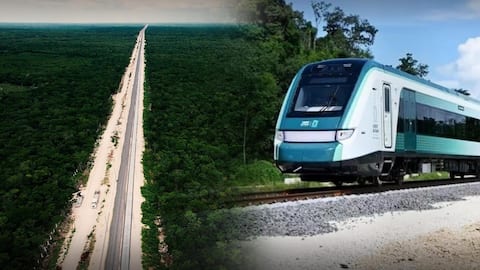Mexico's Maya Train: World's greatest construction project debuts
What's the story
In the heart of Mexico's Yucatán Peninsula, a transformative venture known as El Tren Maya or The Maya Train looms large, promising to redefine the very essence of travel in the region. This colossal rail project, although hailed as a symbol of progress, finds itself at the center of a spirited discourse, with debates echoing through the corridors of economic opportunity and environmental stewardship. Let's look further into Tren Maya and its potential as a game-changer for tourism in Mexico.
Vision
Grand vision
President Andrés Manuel López Obrador's vision for the Maya Train is nothing short of audacious - he envisions it as "the greatest construction project in the world." Spanning a staggering 1,500 kilometers, this ambitious initiative aims to seamlessly connect iconic destinations like Cancún and Tulum to lesser-known regional treasures. In doing so, it aspires to redefine not just transportation but also the very fabric of regional connectivity.
Journey
Journey through time and terrain
More than just a high-speed rail, the Maya Train promises a multifaceted travel experience. Boasting distinct services catering to various preferences, from the economical Xiinbal to the luxurious P'tal, it allows travelers to explore the rich tapestry of the Yucatán Peninsula. From ancient ruins and dense jungles to vibrant towns, the Tren Maya offers a gateway to the region's diverse landscapes and cultural heritage.
Running
Tren Maya is up and running
Mexico has inaugurated the first stretch of El Tren Maya. Spanning 290 miles initially, offering passengers access to the nation's most breathtaking locales. As the ribbon is cut, plans for an additional 600 miles loom, promising a network of over 40 trains and 34 stations across southwest Mexico. El Tren Maya emerges as a transformative force, unlocking previously inaccessible interior regions and redefining the country's tourism landscape.
Concerns
Economic hopes v/s environmental concerns
While the Tren Maya holds the key to economic revitalization, critics, led by the Selvame del Tren campaign, voice significant environmental concerns. The potential ecological impact on endangered species and delicate ecosystems becomes a focal point of scrutiny. As the project unfolds, the delicate balance between economic aspirations and environmental preservation takes center stage and demands a thorough examination.
Voice
Voices of the people
Public opinion on the Tren Maya is decidedly polarized, reflecting the complex tapestry of aspirations and anxieties. On one hand, people in the transportation sector like a Mérida taxi driver see the rail project as a beacon of progress and prosperity, heralding economic upliftment. On the other hand, Mayan communities and environmentalists express deep-rooted fears of displacement from ancestral homes and irreversible environmental damage, setting the stage for a clash of perspectives.
Hope or harm
A megaproject of hope or harm?
For many residents in Mexico's southern regions, the Tren Maya symbolizes development. Yet, its journey is marred by controversies that question its impact on the environment, the rights of Indigenous communities, the fears that suggest the collapsing of the train as it's built over cenotes, and the preservation of Mexico's rich cultural heritage. As it traverses through uncharted territories, the Tren Maya's legacy hangs in the balance, dependent on its ability to navigate these intricate challenges with foresight and respect.
Balance
Delicate balance
As Mexico strides boldly into a new era of modernity, striking a delicate balance between progress and preservation becomes paramount. The Tren Maya's enduring legacy hinges on the nation's ability to navigate these intricate challenges, ensuring that its developmental strides do not come at the cost of irreparable damage to the environment and the cultural fabric of the Yucatán Peninsula.
